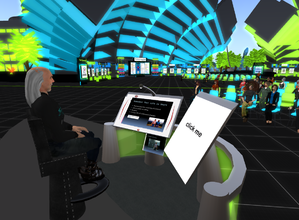From OpenSimulator
(→What is OpenSimulator?) |
|||
| Line 2: | Line 2: | ||
__NOTOC__ | __NOTOC__ | ||
=== What is OpenSimulator? === | === What is OpenSimulator? === | ||
| − | + | {{Template:FrontPageImage}} | |
{{Template:Downloads}} | {{Template:Downloads}} | ||
{{Template:TWIOSD}} | {{Template:TWIOSD}} | ||
| Line 10: | Line 10: | ||
Out of the box, OpenSimulator can be used to simulate a virtual world similar to Second Life™ (including client compatibility), however can be extended with modules to support MXP or realXtend clients too. For a list of availible third party modules, check our [http://forge.opensimulator.org/gf/ forge site]. | Out of the box, OpenSimulator can be used to simulate a virtual world similar to Second Life™ (including client compatibility), however can be extended with modules to support MXP or realXtend clients too. For a list of availible third party modules, check our [http://forge.opensimulator.org/gf/ forge site]. | ||
| − | Although OpenSimulator is still considered '''alpha software''', many people are [http://technorati.com/search/opensim?authority=a4&language=en doing exciting things with it]. | + | Although OpenSimulator is still considered '''alpha software''', many people are [http://technorati.com/search/opensim?authority=a4&language=en doing exciting things with it]. |
=== Features === | === Features === | ||
Revision as of 02:09, 1 March 2009
What is OpenSimulator?
<tr valign="top" style="background: #EEF3E2"><td style="width: 156px; white-space: nowrap; padding: 4px 1em 0 0.5em; border-bottom: 1px solid #aaaaaa;">Image of past Moment:</td></tr> <tr valign="top" style="background: #EEF3E2"><td style="padding: 0px 0 0; background: #F6F9ED; align: center"> </td></tr>
Template:Downloads
<tr valign="top" style="background: #EEF3E2">
<td style="width: 200px; white-space: nowrap; padding: 4px 1em 0 0.5em; border-bottom: 1px solid #aaaaaa;">
This Week in OpenSim Development:
</td>
</tr>
<tr valign="top" style="background: #EEF3E2">
<td style="padding: 1px 1em 0; background: #F6F9ED;">
</td>
</tr>
</td></tr>
Template:Downloads
<tr valign="top" style="background: #EEF3E2">
<td style="width: 200px; white-space: nowrap; padding: 4px 1em 0 0.5em; border-bottom: 1px solid #aaaaaa;">
This Week in OpenSim Development:
</td>
</tr>
<tr valign="top" style="background: #EEF3E2">
<td style="padding: 1px 1em 0; background: #F6F9ED;">
</td>
</tr>
OpenSimulator is a 3D Application Server. It can be used to create a virtual world which can be accessed through a variety of clients, on multiple protocols. OpenSimulator allows you to develop your world using the technologies you feel work best - we've designed the software to be easily extendable through loadable modules to build completely custom environments. OpenSimulator is released under a BSD License, making it both open source, and commercially friendly to embed in products.
Out of the box, OpenSimulator can be used to simulate a virtual world similar to Second Life™ (including client compatibility), however can be extended with modules to support MXP or realXtend clients too. For a list of availible third party modules, check our forge site.
Although OpenSimulator is still considered alpha software, many people are doing exciting things with it.
Features
Even though OpenSimulator is relatively young software it already has many useful features
- Supports creating multiple 'worlds' in a single application instance.
- Supports multiple clients and protocols - access the same world at the same time via multiple protocols.
- Extensive ability to customize your avatar, both with custom clothing, skins, and attached objects.
- Realtime Physics Simulation, with multiple engine options including ODE, PhysX, Bullet and more.
- The ability to create content real time in the environment using in world building tools. What you see is what you get.
- In world application development using a number of different languages, including LSL/OSSL, C#, JScript and VB.NET
Using OpenSimulator
The fastest way to get started using OpenSimulator is to create an account on OSGrid, then download the Hippo Viewer or Linden Lab's Second Life viewer (amongst others) to connect to OSGrid. This process should take no longer than 10 minutes, and will give you a flavor for what OpenSimulator is like.
You can also easily connect to any one of the many public grids on the internet.
Or you could run a simple standalone OpenSim on your Windows desktop to create and preview content. Here is an tutorial showing how to get opensimulator in stand-alone mode..
Running your own OpenSimulator
If you are interested in running your own OpenSimulator server, to host your own 3D environments you'll want to check out the following links:
- Getting OpenSimulator
- Building OpenSimulator
- Configuring OpenSimulator
- Running OpenSimulator
- Frequently Asked Questions in Running OpenSimulator
Participating in the OpenSimulator Community
OpenSimulator is an open source project, and is powered by the community members that devote time and energy to the effort. There are many ways to participate and contribute to the community:
- Participate via IRC - #opensim (for users) and #opensim-dev
- Contribute to this wiki, making the OpenSimulator documentation even better.
- Report bugs, submit patches or submit content contributions via our mantis bug tracker
- Create an OpenSimulator related project hosted on the Forge or elsewhere on the web. In the forge there are over a dozen registered projects, and it's a great way to further extend the OpenSimulator community.
- Blog about OpenSimulator, and let us know about that blog on #opensim so it can be added to Planet OpenSim
- Participate in one of the weekly Office Hours for OpenSimulator. We currently have weekly office hours for development, wiki work, and testing.
- Secure project infrastructure by donating to the OpenSim Project Infrastructure Fund.
Pages by Category: User's Pages, Development Pages, Scripts, Recent Wiki Changes
Wiki Translations: Spanish, German, Francais, Italian, Português, Japanese
UNIQ6d699d5e4d99d1b0-cleanpage-00000000-QINU
